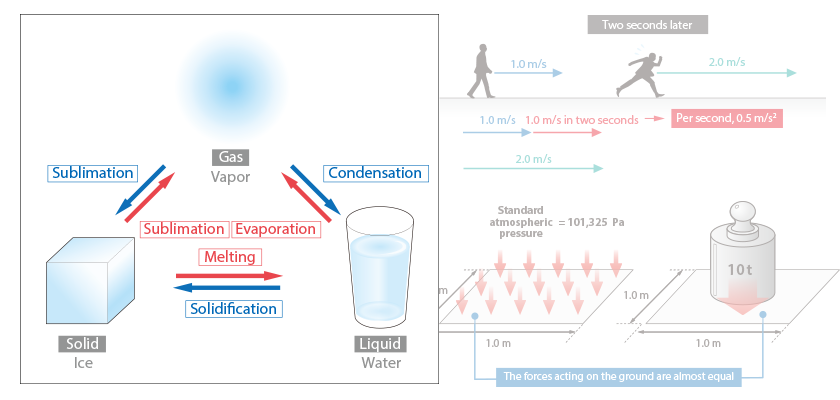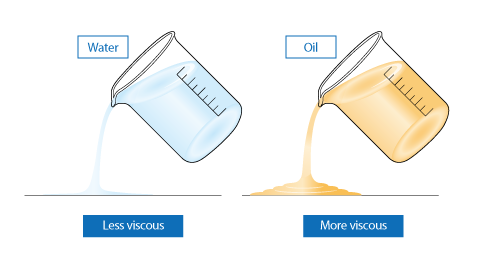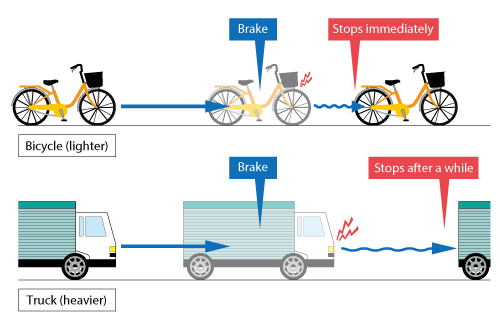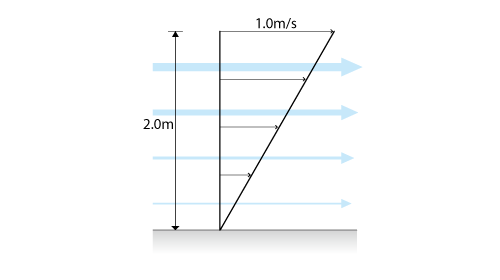Want to Know More! Basics of Thermo-Fluid Analysis 9: Chapter 2 Properties of matter 2.6 Viscosity and kinematic viscosity coefficient

2.6 Viscosity and kinematic viscosity coefficient Fluid
Viscosity coefficient is the degree of fluid stickiness and its unit is [Pa∙s].
We feel that cooking oil is stickier than water at 20°C. Let us compare their viscosity coefficients. They are approximately 0.001016 [Pa∙s] for water and 0.06 to 0.08 [Pa∙s] for oil. We can see the viscosity coefficient of oil is 60 to 80 times as large as that of water.

Figure 2.10 Difference of viscosity
When force is applied and relative relation of molecular position is to be broken, molecules try to stay at their fixed positions. This causes the resistance. That is why a fluid has viscosity. In most cases, liquids have larger viscosity coefficients than gases because links of molecules are tighter in liquids than in gases.
Viscosity works as a brake to a flow, and the effectiveness of the brake depends on the density of a fluid. For example, let us see a bicycle and a truck running at the same speed. Even if brakes at the same power are applied to both, they will stop differently because they have different weights.

Figure 2.11 Weight and braking effectiveness
As we have seen above, to consider how viscosity effects a flow, we need to know the density of the fluid. Here, a measure called “kinematic viscosity coefficient” is used. It is derived by dividing viscosity by density, and its unit is [m2/s].
Want to know more Units of viscosity and kinematic viscosity coefficient
Because a fluid has viscosity, friction occurs between two fluids or between a fluid and a solid. This friction is called “shear stress” and its unit is [Pa]. Additionally, the degree of velocity variation against distance is called “velocity gradient”, and its unit is [1/s]. Let us see the figure 2.12 as an example. The velocity changes 1.0 [m/s] over the distance 2.0 [m]; therefore, the velocity gradient is expressed as 1.0 [m/s] / 2.0 [m] = 0.5 [1/s].

Figure 2.12 Velocity gradient
Viscosity coefficient is the degree of shear stress per unit velocity gradient, and its unit is [Pa] / [1/s] = [Pa∙s].
The idea of kinematic viscosity coefficient may be a little bit difficult to grasp. It shows how easily a flow travels. A flow propagates to the surroundings through viscous force; however, even when two fluids have the same degree of viscosity, in other words, the same degree of ease in traveling, one fluid with higher density has more difficulty to flow because it is heavier. That means the flow has “difficulty in traveling”. In contrast, the other fluid with lower density can flow more smoothly because it is lighter. The flow can have “ease in traveling”.
Magnitude relation between two kinematic viscosity coefficients significantly differ from that between two viscosity coefficients. Let us compare air and water at 20°C and 1 atm (= 101,325 Pa). For viscosities, air (1.83×10-5 [Pa∙s]) < water (101.6×10-5 [Pa∙s])is true; however, the relation is reversed for kinematic viscosity coefficients. The relation of air (15.01×10-6 [m2/s]) > water (1.004×10-6[m2/s]) is true. This shows that water is more viscous than air; however, air has more ease in traveling. For example, when fanned, the air flow reaches far; in contrast, water hardly flows.
Although the unit of kinematic viscosity coefficient is quite difficult to memorize, it is [m2/s]. It may be clearer if you understand that it has the dimension of areal velocity.

About the Author
Atsushi Ueyama | Born in September 1983, Hyogo, Japan )
He has a Doctor of Philosophy in Engineering from Osaka University. His doctoral research focused on numerical method for fluid-solid interaction problem. He is a consulting engineer at Software Cradle and provides technical support to Cradle customers. He is also an active lecturer at Cradle seminars and training courses and the author of serial articles Basic Course of Thermo-Fluid Analysis.


